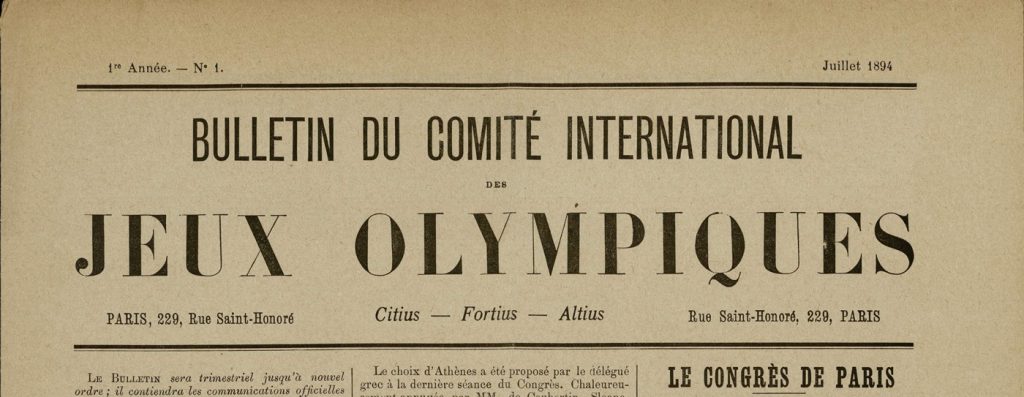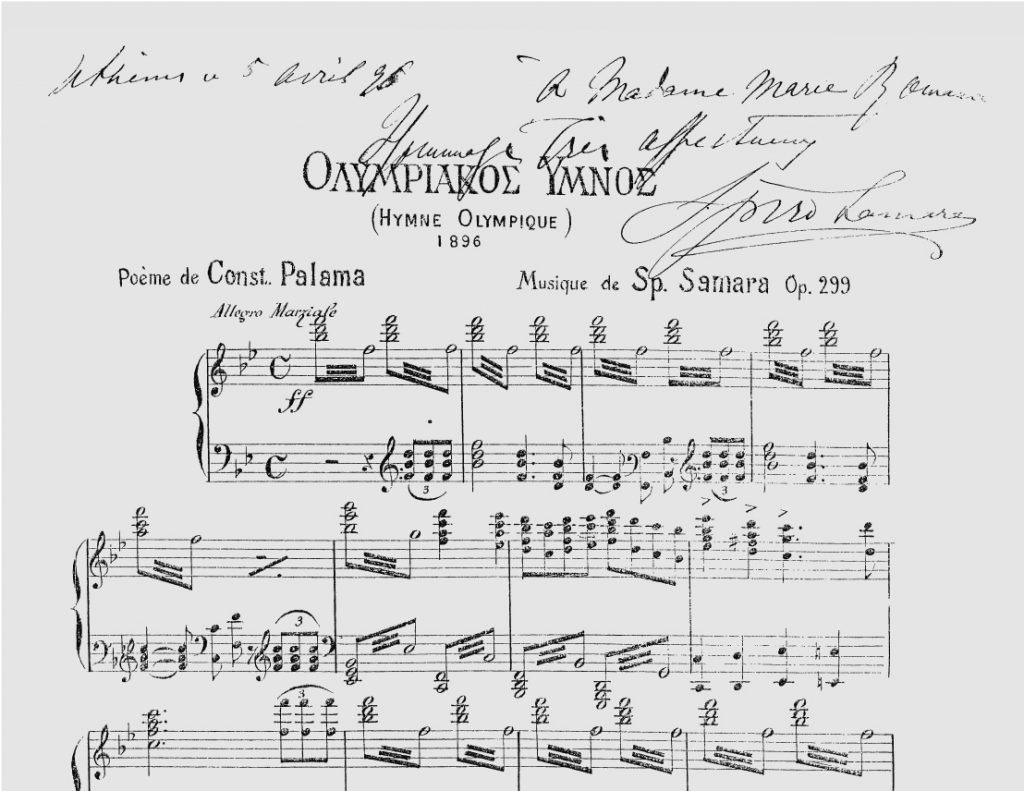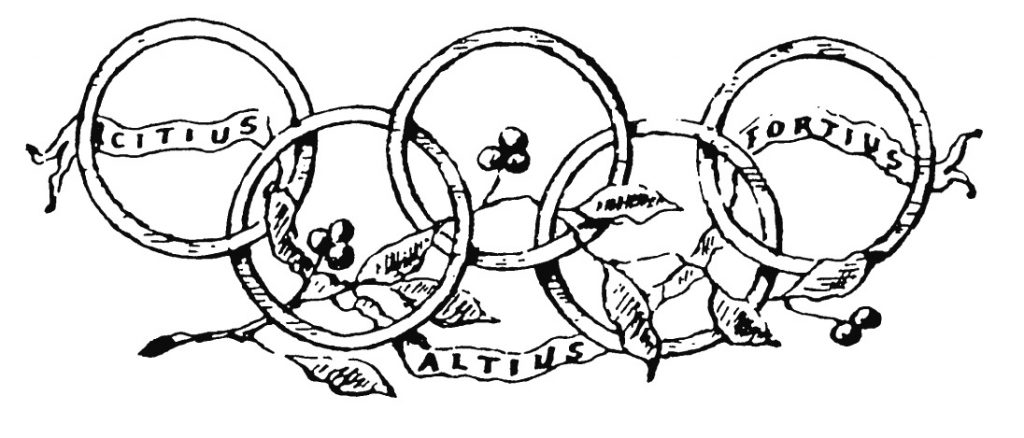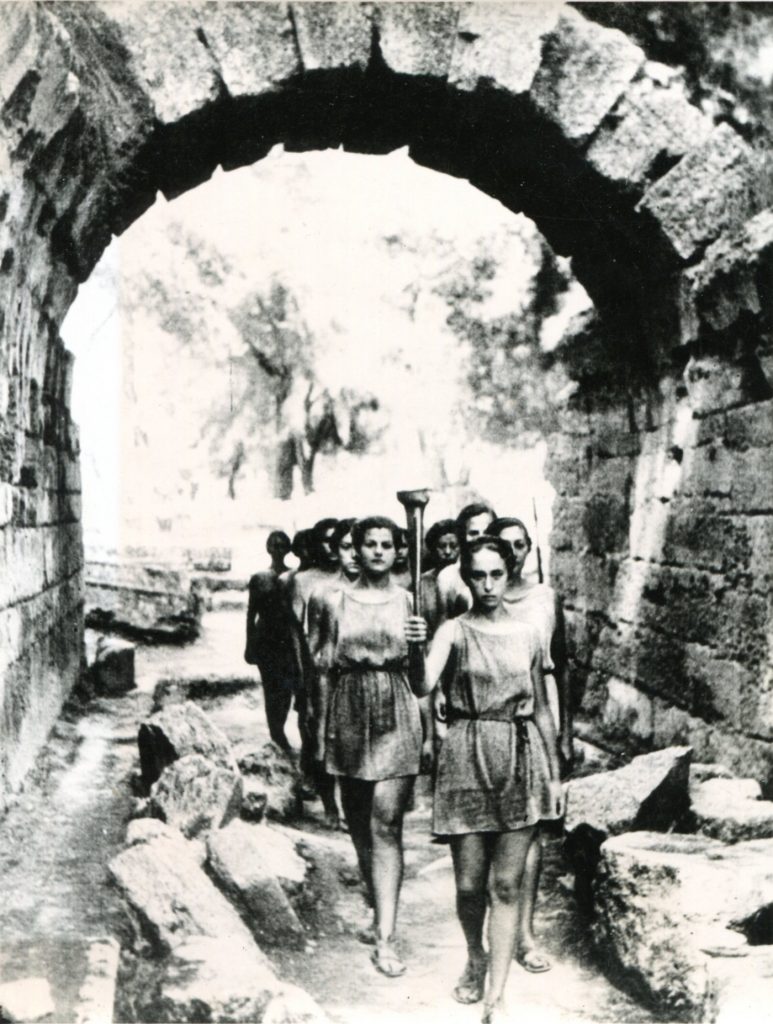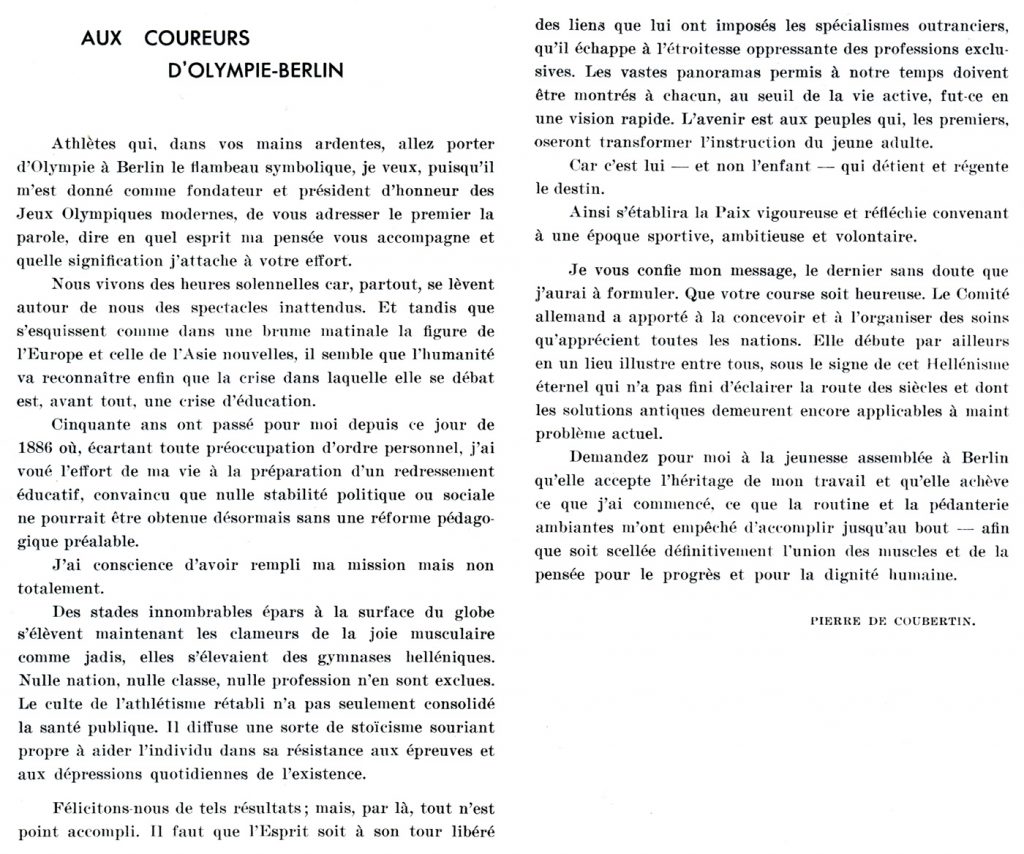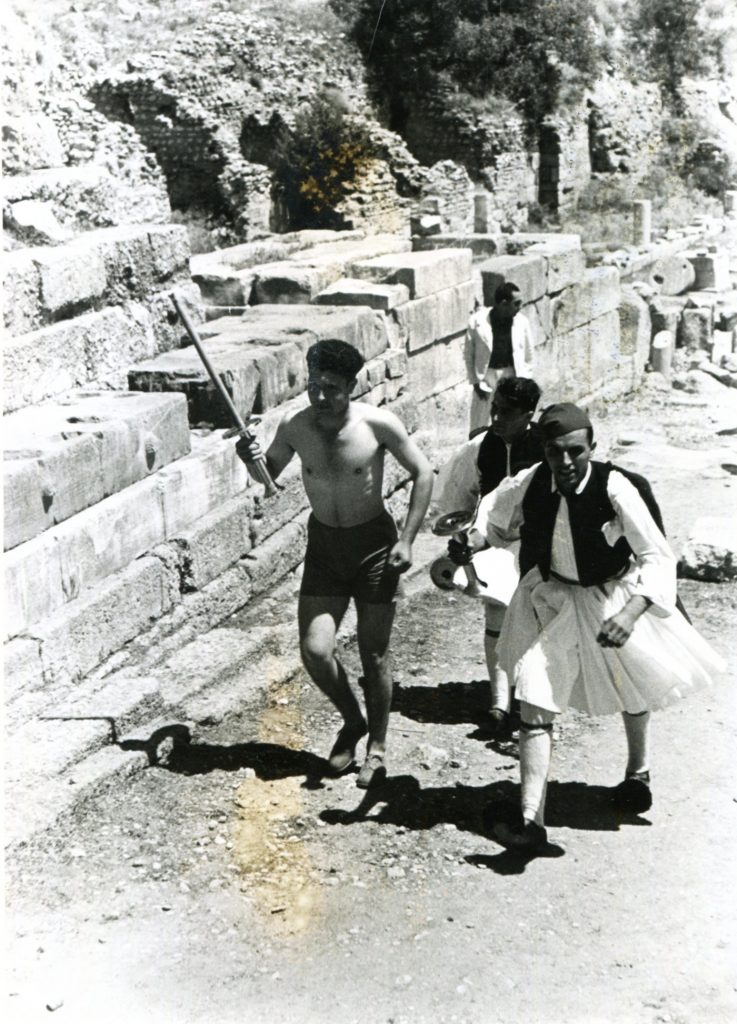The Olympic Rituals and Symbols
Stephan Wassong
At the closing ceremony of the Olympic Foundation Congress at the Sorbonne on 23rd June 1894 Pierre de Coubertin proposed the three words formulated in the Latin comparative citius – altius- fortius as the motto for the Olympic Movement. The motto itself was coined by Father Henri Didon who was headmaster at the Dominican Albertus Magnus College in Arcueil. Didon, who was an advocate of the educational value of sport in school settings, organised the first sport festival at his school on 7th March 1891. On the occasion of this school’s sport event, he spoke to his students about the motto citius – altius – fortius, which he regarded as the nature of sport and sportsmanship par excellence. Coubertin attended the sport festival in his function as the then secretary general of the Union des Sociétés Française de Sport Athlétiques (USFSA) which was the umbrella organisation of school sports clubs in France. Obviously, he was impressed about the motto and its significance. Only a few days later he quoted this motto in a report on the school sports festival in the journal Les Sports Athlétiques.
In its early Olympic usage, the terms altius and fortius “have been swapped, perhaps for stylistic reasons or perhaps because the contrast between citius and fortius is stronger than citius and altius”.[1]In the sequence citius – fortius – altius the motto was printed for the first time in the Official Bulletin of the International Olympic Committee (IOC) in 1894.
Cover of the Official Bulletin of the IOC
July 1894
The Olympic motto in its well-known sequence citius – altius – fortius appeared for the first time and then together with the Olympic rings at the Olympic Congress in Paris in 1914 which marked the 20th anniversary of the Olympic Movement.
Opening bars of the Olympic anthem.
Georgios Dollanitis Collection
On this occasion Coubertin presented the Olympic flag with its five rings on a white background. He had designed it in 1913 already. The blue, black and red rings at the top interlaced with the yellow and green ones at the bottom should demonstrate the bonds of friendship and mutual respect between the continents. The individual rings do not stand for a specific continent. At least one of the five colours could be found in the national flag of the nations which had competed at the Olympic Games from Athens in 1896 to Stockholm in 1912. As the 1916 Berlin Olympic Games had not been held due to the First World War, the flag had its Olympic debut at the 1920 Antwerp Olympic Games.
Of course, today`s Olympic rituals were not all invented by Coubertin but found his approval, as from the beginning he wanted to imbed the Olympic Games into a festive and honourable atmosphere, to distinguish them from any other international sport championship. Coubertin was of the opinion that the Olympic Games should be focused on fair competitions and celebrated in a joyful atmosphere. According to Coubertin this was the basis for the implicit acquisition of moral and social values to which Olympic sport and sport in general were said to contribute to. The concept of amateurism could be linked to this as professionalism, with its overemphasis on winning to earn one`s daily living, would have the tendency to undermine the principle of fair play and the joy of sport competitions. But next to safeguarding the eligibility rules, a joyful atmosphere should also be created by the beauty of the Olympic festival. In this assumption Coubertin was influenced by the English philosopher John Ruskin for whom “the outer beauty simply reflected the outer (one)”[2]. Coubertin transferred this to the Olympic Games and elaborated on it in five articles published in the The Revue Olympique in 1911. He coined the term ´sporting Ruskinism´ to conceptualize the Olympic approach respectively to ´beauty´ and ´aesthetics´. For athletes and spectators alike, the competition itself does not only coin the unique atmosphere of the Olympic Games, but this is realized by the necessary imbedding of competitions into a festive framework consisting of various elements. The intended balanced combination of amateur sport and festive elements should lead to the experience of harmony which Coubertin, who referred to this as eurythmics, perceived as relevant for the educational objectives linked with the Olympic Games. A few of these festive elements are mentioned in the following:
For Coubertin the Olympic Games with its educational mission had to be celebrated with festive songs and selected festive music. Already at the opening ceremony of the founding congress at the Sorbonne in 1894 Coubertin praised the performance of the Hymn to Apollo, which had been discovered in Delphi in 1893. It was transcribed by Théodor Reinach and set to music By Gabriel Fauré. As to Coubertin, it should form the glorious highlight of the event:
“The two thousand persons present listened in a religious silence to the divine melody risen from the dead to salute the Olympic renaissance across the darkness of the ages,”[3]
At the 1896 Athens Olympic Games the Olympic anthem was composed by the Greek Spyridon Samaras with lyrics written by the poet Kostis Palamas. It was received with great enthusiasm by Coubertin. He praised “the beautiful cantata composed by the Greek musician Samaras”[4], and even if he does not explicitly mention Palamas, this does not mean criticism. His praise of the hymn as a poetic and artistic arrangement definitely applied to both artists. Since 1958 this anthem has become the official Olympic hymn.
The Olympic motto with the five rings, drawn by Coubertin himself.
Navacelle Collection
The honoring of the athletes was also a welcome element for Coubertin to the festive design of the Olympic Games and he welcomed the ceremonial performed in Athens. Although there were some links to the ancient Olympic Games, which Coubertin definitely approved, the ancient victory models were only additions. A silver medal was awarded to the athletes who were placed first in the competition; a copper medal was given to the 2nd placed athletes. No medal was awarded to the athletes who won the 3rd place. Athletes who won a competition were given a diploma and an olive branch. A laurel branch was the present for the athletes who were ranked second. The special festive element of the ceremony was that the members of the Athens Olympic Organizing Committee and of the IOC lined up together in the Panathenaikon Stadium together with the athletes at the end of all competitions. After a herald`s call one athlete after the other climbed up the stairs to receive his awards.
Since the Olympic Games in St. Louis in 1904 gold, silver and bronze medals have been awarded to the athletes. The winners’ podium, often so imposing at the Olympics, was first used in 1932 at the Winter Olympics in Lake Placid; since then it has been used in Olympic Winter and Summer Games. It was not an idea of Coubertin but of his successor Count Henri Baillet-Latour. He learned about this form of award ceremony at the 1930 British Empire Games in Hamiliton in Canada. Previously, the honors were traditionally performed by a member of the royal family who stood on a pedestal over the athlete or in the royal lodge. With the introduction of the winning podium, the positions were eventually swapped and the athlete has since received a special symbolic appreciation. Award ceremonies were, however, only carried out until the Olympic Games in Amsterdam in 1928 by the royal heads of state themselves or their family representatives. Since 1932, this task has been taken over by IOC members and sports association officials. Also, since 1932, the award ceremonies have been held directly, but at the latest, one day after the final competitions. Previously, the honors had been integrated into the closing ceremony, while at the 1932 and 1936 Olympic Summer and Winter Games all the awards ceremonies took place immediately after the competitions at the Olympic Stadium, the IOC decided since the 1948 London Olympic Games to perform the winning ceremonies at the respective competition venues.
The Olympic oath was a long held wish of Coubertin and was discussed at the Olympic Congress in Paris in 1914 for the first time. Again, due to the cancellation of the 1916 Berlin Olympic Games it was first taken at the opening ceremony of the 1920 Antwerp Olympic Games. The Belgium fencer Victor Boin was selected as the speaker of the oath and said the following words:
“We swear that we are taking part in the Olympic Games as loyal competitors, overserving the rules governing the Games, and anxious to show a spirit of chivalry for the honour of our countries and for the glory of sport.”[5]
Another ritual for festive creativity for Coubertin was the element of fire as a representation of truth, reason, freedom and the creativity of humanity; the relation to the Greek mythology is again laid out here in the thinking of Coubertin. Already at the Foundation Congress of the Olympic Games in 1894 in Paris he used the element of fire to create a festive atmosphere. An example for this were the torch relays over 150m, 500m and 200m which were held at the Fête de Nuiton 17th June 1894.
Against this background of appreciation of fire as a festive element, it is not surprising that Coubertin welcomed the launch of the Olympic Flame at the 1928 Amsterdam Olympic Games. The idea for the implementation of this ritual of Olympic Games, which is so well-known now, must be attributed to the Dutch Jan Wils, who was the architect of the Olympic stadium in Amsterdam. For the duration of the Olympic Games the official Olympic flame was burning in a cauldron on top of the stadium’s Marathon Tower.
Of course, the Olympic flame is linked with the torch relay, of which the first edition was held for the 1936 Berlin Olympic Games. Coubertin did not propose the introduction of a torch relay into the Olympic protocol. But even before 1936 and on different occasions Coubertin described the cultural and educational value of a torch relay for the Olympic Movement in a metaphorical way.
Closing Words Stockholm 1912:
“And now, Gentlemen, through our mediation a great people has received the torch of the Olympiads from your hands, and has thereby undertaken to preserve and if possible, to quicken its precious flame.”
Closing Words, Antwerp 1920:
“May the Olympic Torch follow its course throughout the ages for the good of humanity ever more ardent, courageous and pure.”[6]
Olympic Memoirs: The Four War Years (1914 – 1918)
“…if the war were one day to prevent an Olympiad from being celebrated in Europe, the following would be staged there, and if the youth of this continent were temporarily forced to relinquish the Olympic flame, there would be another youth on the other side of the world ready to take over.”[7]
The idea of the Olympic torch was put into practice by Carl Diem, who strongly shared Coubertin`s Olympic idea and never tired of disseminating knowledge on it in books, articles, official speeches and lectures at universities. One of his first written sources on the idea of an Olympic torch relay dates back to 25thAugust 1931. His initiatives to plan a torch relay for the 1936 Olympics in a more detailed way found the support of Coubertin. According to Diem and in full accordance with Coubertin the torch relay would provide a link between antiquity and modern times. The IOC itself approved the introduction of the torch relay for Olympic Games in Berlin on its meeting in Athens on 18thMay 1934. The idea was also shared by Ioannis Ketseas who was the then secretary general of the Hellenic Olympic Committee (HOC). He collaborated with Diem closely in the planning of the torch relay. It was Ketseas who came up with the first plans of lighting the flame for the torch.
The torch relay started on 21st July 1936 at the archaeological site in Olympia. Like today the flame was lighted by the rays of the sun in a concave mirror in the presence of female actors dressed as priestesses. This happened at the starting lines (balbides) in the ancient stadium which was not yet excavated. The balbides were found during the first excavation period which lasted from 1875 till 1891. With the sparks of the flame a copy of an ancient torch was lit. In a procession of the female priestesses the torch was brought through the stadium tunnel into the altis. There the procession passed the temple of Hera and went on to a fire altar which was set up at the new entrance of the altis, north of the Prytaneion.
Procession of the flame.
Archive of the Olympic Studies Center of the German Sport University Cologne
The Coubertin stele, set up at the (old) entrance of the altis in 1927, was relocated to the place of the altar. There the torch of the 1936 Berlin Olympic Games was lit and the first runner started. Before that Coubertin`s message to the torch runners was read out.
Message of Pierre de Coubertin to the torch relay runners.`{`8`}`
The torch relay lasted 12 days and 3,331 runners were involved in carrying the flame through Greece, Bulgaria, former Yugoslavia, Hungary, Austria former Czechoslovakia and Germany. The torch arrived in the Olympic Stadium in Berlin on 1st August.
The Olympic torch relay in Delphi.
(Archive of the Olympic Studies Center of the German Sport University Cologne
In its core ceremonies today`s torch relays are very similar to the ones in 1936. This is above all true for the festivities in ancient Olympia. Today the flame is in front of the temple of Hera and brought into the ancient stadium. There the official Olympic torch is lit and carried to its first stop: the Coubertin monument located at the premise of the International Olympic Academy.
[1] Müller, Norbert: The Olympic Motto „Citius, Altius, Fortius” and its Author Henri Didon. In: Nikephoros. Journal of Sports and Culture in Antiquity. Special Issue 2012. Youth – Sports – Olympic Games.
[2] Müller, Norbert: One Hundred Years of Olympic Congresses 1894 – 1994. History – Objectives –Achievements. Niedernhausen 1994, 70.
[3] Coubertin quoted in: Ibid, 31.
[4] International Olympic Committee (Ed.): Olympic memoirs by Pierre de Coubertin Lausanne 1997, 44.
[5] Quoted in: Renson, Roland: The Games Reborn. The VIIth Olympiad, Antwerp, 1920. Antwerp 1996, 33.
[6] Coubertin quoted in: Borgers, Walter: Olympic Torch Relays. 1936 – 1994. Kassel 1996, 12.
[7] Coubertin quoted in: International Olympic Committee (Editing Director: Norbert Müller): Pierre de Coubertin 1863 – 1937. Olympism Selected Writings. Lausanne 2000, 582.
[8] Coubertin quoted in: Borgers, Walter: Olympic Torch Relays. 1936 – 1994. Kassel 1996, 46.


